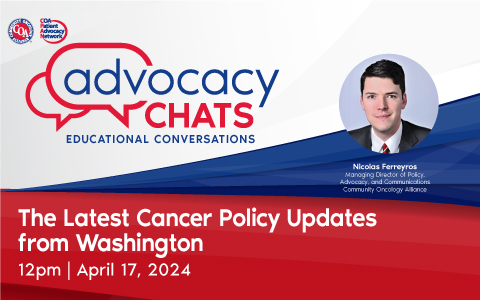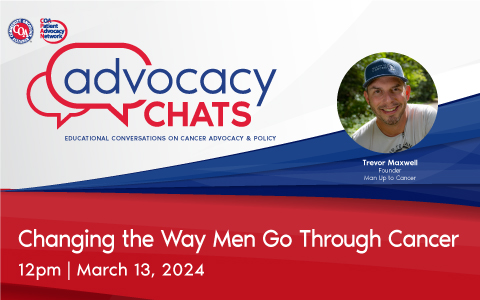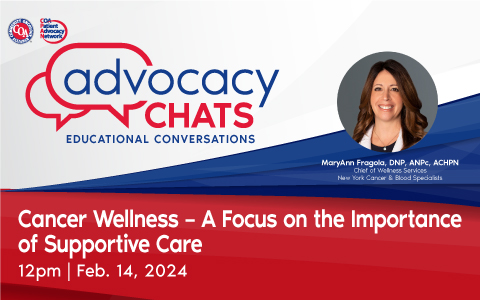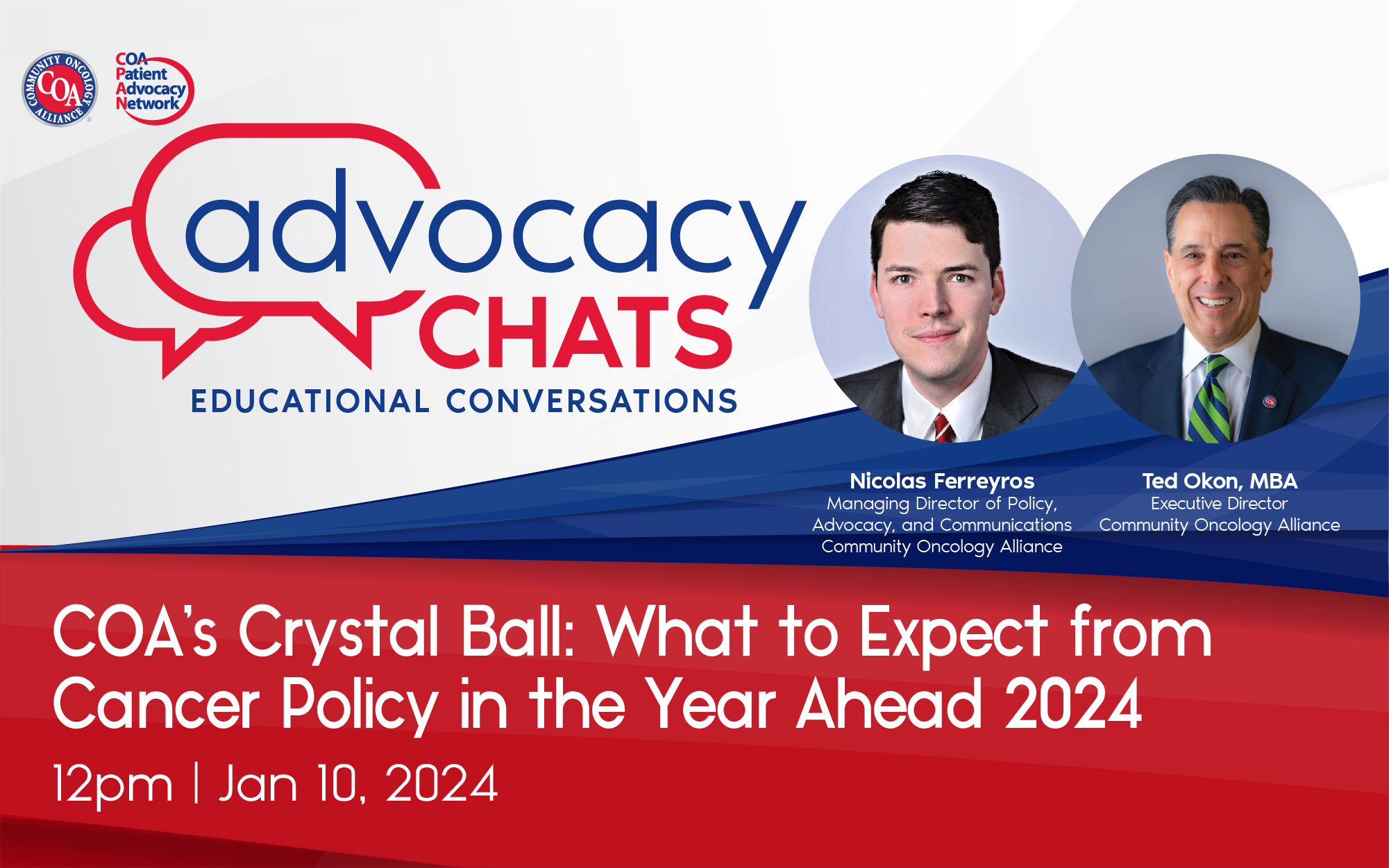Caring for the Caregivers: Supporting the Families and Friends of Patients
December 8, 2021 Often, caregivers are going through challenges, many of which are the same as those the patient with cancer experiences. The needs of caregivers are often overlooked. This month, CPAN is bringing in the CEO of an organization, founded in 1993, John Schall, MPP, of Caregivers Action Network. A key part of last month’s Advocacy Chat talked about the challenges patients with cancer experience. The emotional stressors of oncology patients are well known, and people are often drawn to immediately help the newly diagnosed patient. The significant role and stressors on caregivers are less known.
Prior to joining the Caregivers Action Network, John had an extensive health policy background from both the standpoint of the White House and Capitol Hill. He was on the White House staff for President George H.W. Bush as Deputy for the Domestic Policy Council, handling many domestic issues, which included health care, and was always at the top of the policy list. He also worked for former Senate Majority Leader Bob Dole. Even though today’s talk will focus on issues from the caregiver’s vantage point, much of this dovetails off the psycho-social issues of last month’s Chat.
Caregiver Action Network
The Caregiver Action Network (CAN) was founded over 30 years ago and is the nation’s leading consumer-facing caregiver organization. There are tens of millions of caregivers across the country who are caring for elderly relatives, loved ones with chronic conditions, or whatever situation presents itself. It is no mystery to anyone that a lot more care has been pushed to the home in recent years. It is very obvious in the oncology space. If we go back 25 years, what are now outpatient infusions were an inpatient procedure for which the patient may have stayed in the hospital for a couple of days. Those days are long, long gone, and that care has been pushed to the home. While none of us is born knowing how to provide this care, two out of every five adults are now a family caregiver or caring for someone close to them. Even though millions of us are doing it, caregiving can feel very isolating.
- CAN helps the over 90 million family caregivers in the U.S.
- These family caregivers are caring for:
- An older loved one dealing with the impacts of aging.
- A spouse with a chronic condition or disability.
- A child with significant health care challenges.
- A family member or loved one diagnosed with a mental illness.
- CAN helps family caregivers prioritize their own mental health and establish self-care.
- CAN helps family caregivers feel resourceful, supported, and heard.
Who Are the Caregivers?
Caregiving really is across the lifespan and across the board. People tend to think of a caregiver as someone who is caring for an elderly parent. That is true as cases of Alzheimer’s disease are on the rise. The same is true at the other end of the spectrum with the increase in the number of cases of autism. The latest figures show one out of every 44 children is affected with some form of autism. Not only across the lifespan, but caregiving is also across all therapeutic conditions. Caregivers who come to the Caregiver Action Network for information and support tell stories that include:
- My mother has Alzheimer’s. I am all she’s got.
- I am caring for my sister who has breast cancer.
- I am new to caregiving and I am overwhelmed.
- My daughter has a rare disease.
- My wife was just diagnosed with MS.
- My elderly parents live in another state.
- I am caregiving while trying to hold down a job.
Even with so many situations and conditions, we have learned that, regardless of the therapeutic condition for which the caregiver is providing care, about 80 percent of the issues that come up are much the same. The remaining 20 percent differ tremendously depending on what condition is being cared for. It is important not to think of a caregiver as having one profile.
Not only can caregiving be vastly different depending on the therapeutic condition, but it can also be different depending on the place one is in caregiving. It can depend on which one of the almost 50 types of cancer the patient may have. In addition, it can depend on how the caregiver has come into the situation. One of the things the Network tries to do, as evidenced by its website, is to tailor information to where the caregiver might be at that time.
For some people, something has just happened, and a person finds that he is suddenly a caregiver. That person needs different resources than others might need. Or a person may have been a caregiver for years, but some occurrence has changed things. This is particularly true when caring for patients with Alzheimer’s. The condition comes on gradually, but if the patient has a stroke, things are suddenly different. “I just realized I am a family caregiver” is hugely different from having been a caregiver for years.
In his own case, John Schall is in Washington D.C. and his mother, for whom he is a caregiver, is in Michigan. Caregiving for someone locally is vastly different from long-distance caregiving. Caregiving while trying to maintain a job also presents many obstacles. We tend to think of caregiving as an elderly person caring for their spouse. Or “mom is home anyway,” so she can care for her mother-in-law. Most often that is not the case.
The vast majority of caregivers are holding down full-time jobs, and the caregivers themselves skew much younger than most people would think. Most caregivers are in their prime working years of ages 25-54. Typically, the person being cared for has comorbidities, often two or three comorbidities. Caregivers are often not dealing with just one condition. Many characteristics of caregiving are near universal:
- Family caregivers and their loved ones are the only people present across all care settings. This means they:
- Are the hospital, in the doctor’s office, working with the pharmacist.
- Are in the hospital when a nursing staff shift starts and are still there when the nursing staff shift changes.
- Family caregivers have the desire to make sure their loved one is as healthy and has as high a quality of life as possible.
- Family caregivers have an intimate knowledge of the patient.
- Know their loved ones better than anyone else and are often with them 24/7.
- Have the best observational status of the person they are caring for.
- Have the best insight into the symptoms, progression of disease, and side-effects of any medications.
- In the case of oncology, can make irreplaceable observations and thus their input should be incorporated into the physician’s care plan.
- Family caregivers see the patient in their own homes and for longer periods of time than anyone in the provider community.
That intimate knowledge actually matters a lot when it comes to real care. For example, if while caring for someone with Parkinson’s Disease, the caregiver knows what time of day tremors usually occur or when the patient goes into what is known as an “off period,” then the caregiver knows how to better plan the day’s activities to accommodate the disease.
Family caregivers not only provide transportation and grocery shopping, but they often provide sophisticated medical care. Up to 50 percent of the time, it is actually the family caregiver who is managing the medications rather than the patient themselves. The more serious the condition, the more likely it is that this responsibility is assumed by the caregiver. If we are thinking about adherence and compliance of medications, the family caregiver role is central. More than half of the 90 million caregivers are providing sophisticated tasks at home that are normally associated with doctors and nurses. They are performing tasks such as:
- Wound care
- IVs
- Infection monitoring
#CaregiverAnd Campaign
November is National Family Caregiver Month. The Network launched the #CaregiverAnd campaign nationally to allow family caregivers to be able to express themselves. The Network wanted to highlight this hugely vital role and bring awareness to how it can crowd out everything else in the caregiver’s life. The campaign reinforces how important it is for caregivers to stay connected with the other aspects of their lives so they can continue to provide care safely. When developing the campaign, the Network was fascinated with the number of cancer caregivers that responded. They sent in their pictures, the passions in their lives, and told what type of cancer for which they were providing care.

The campaign reminds everyone that at some point caregivers must take a step back and address the other priorities in their lives.
Help for Cancer Caregivers
It is not just that caregivers need to stay connected with those things they love. There is a health benefit. The sheer stress of being a family caregiver takes a huge toll on the caregiver’s own health. Family caregivers are twice as likely to suffer chronic conditions – like hypertension, diabetes, stroke, depression. Keeping in touch with other aspects of the caregiver’s life, helps combat these conditions and helps prevent caregiver burnout. A wife caring for her husband is more than six times as likely to suffer depression as a non-caregiver wife.
Some support is condition dependent, so the Network has launched a whole separate site for cancer caregivers that focuses on the resources most commonly needed by them. The Network’s Help for Cancer Caregivers site, HelpForCancerCaregivers.org/, provides those caring for loved ones with cancer with numerous tools and resources to help tackle the unique challenges they face.
Resources are offered in the following categories:
- Bereavement
- Caring from Afar
- Coping Emotionally
- Keeping Healthy
- Practical Matters
- Working Together
There are psycho-social issues that are part of caregiving, in addition to details like how to do wound care, how to manage medications, or how to talk to the doctor. There can be feelings of:
- Guilt – Am I providing good enough care?
- Depression – the caregiver’s, not the patient’s
- Exhaustion – I am simply exhausted by all I must do each day.
- Anger – This is not what I signed up for and I am stuck in this role.
The caregiver must find a way to express these issues and feelings as they cannot be expressed to the patient. The website allows the caregiver to answer some questions in order to tailor the appropriate resources to what the caregiver is feeling at that point. Caregiving is a little like life itself – at some point everything from A to Z will come up. The site aims to narrow the vast number of issues to those most needed at that time.
The site also recognizes that cancer caregivers are often dealing with some profound comorbidities and provide video resources on dealing with a patient with cancer who also has one or more common conditions such as:
- Schizophrenia
- Alzheimer’s Disease
- Huntington’s Disease
- Parkinson’s Disease
- COPD
- Need for hands-on care -for such things as how to transfer someone from the bed to a wheelchair or how to walk a patient to the bathroom to make sure toileting works.
The caregiver can often be on a psychological rollercoaster. For example, when the patient passes away, caregivers can feel guilt. Sometimes it’s because they wonder if the care they provided had been better, might the patient still be alive; or because they feel a sense of relief over the burden lifted from them. Bereavement on the oncology space must deal with both and is quite different than if the patient had a fatal, unexpected heart attack, for example. With cancer, much of the bereavement actually happens before the patient’s actual passing. The video series deals with this issue.
The psychological rollercoaster the patient is on is quite different than the one the caregiver is on. At some point, the patient may go into remission and feel a sense of elation that he does not have to deal with cancer for a time. The caregiver may be in a quite different place because he is thinking that the remission is wonderful, but they are waiting for the next shoe to drop. That is why it is critical that the caregiver be able to reach out for resources that address caregiver needs.
Caregiver Help Desk
The Caregiver Help Desk offers free support to family caregivers across the country. It is staffed by caregiving experts who can help find the information a caregiver needs to navigate challenges and support the caregiving journey. The Caregiver Help Desk can:
- Have confidential conversations with caregiving experts about caregiving questions.
- Reach out by phone, email, and live chat.
- Make experts available Monday through Friday, 8:00 a.m. – 7:00 p.m. ET.
The mission of the Caregiver Action Network is to promote resourcefulness and respect for the more than 90 million family caregivers across the country. While the respect for oncologists, chemotherapy nurses, and oncology pharmacists may be automatic, there may be an unconscious “what do they know” bias about caregivers. The Network strives to make patients and caregivers alike understand the valuable and often sophisticated role the caregiver fulfills.
More information is available at:
- CaregiverAction.org
- John Schall, Chief Executive Officer, CAN
- (202) 454-3970
- [email protected]
- Twitter: @CaregiverAction
- com/CaregiverActionNetwork
CPAN Advocacy Chats are regular virtual 30-minute educational conversations about cancer advocacy and policy with a guest speaker invited to discuss issues important to patients and advocates. Summaries of previous Advocacy Chats are available on the CPAN website.
Past Advocacy Chats

